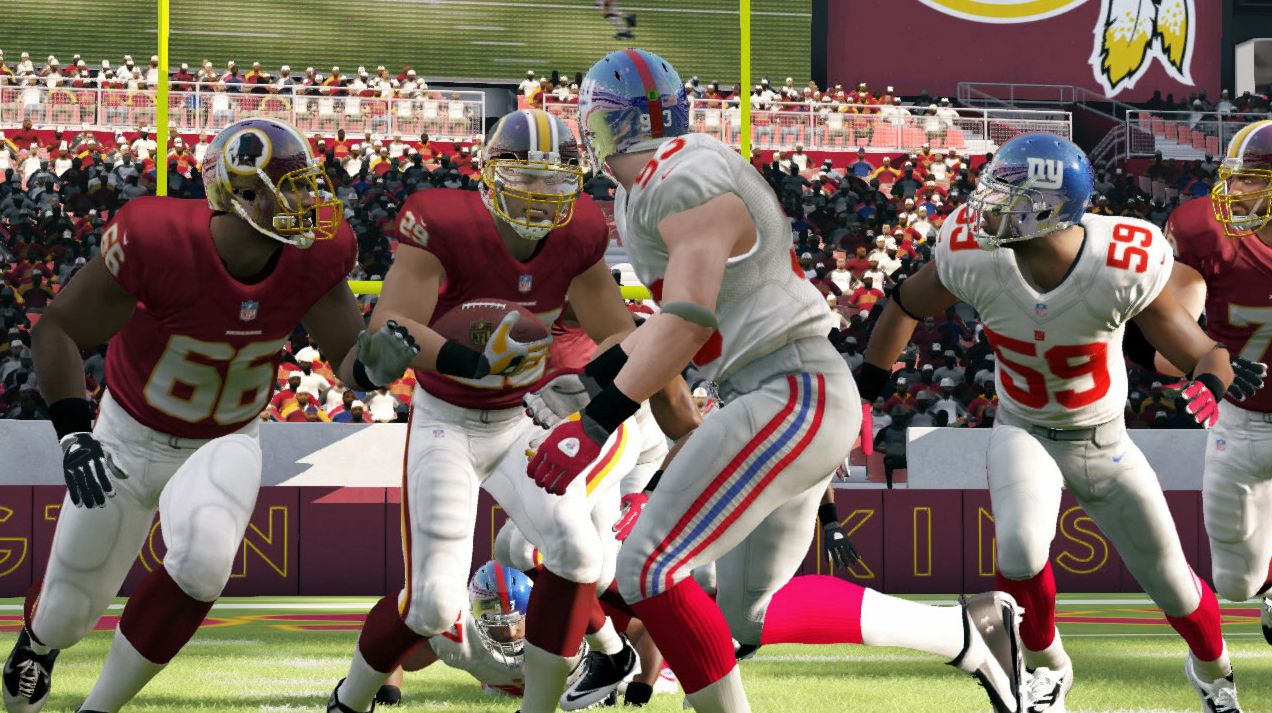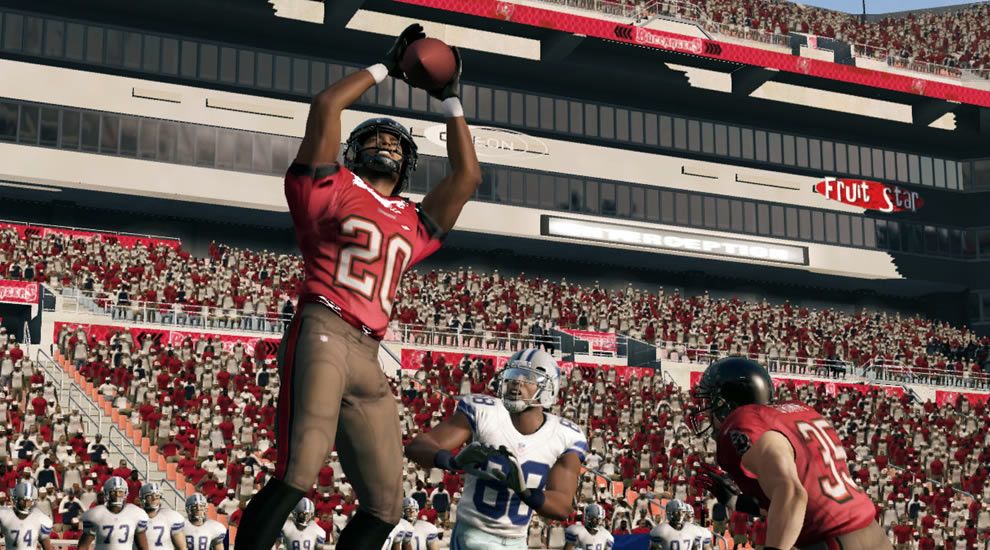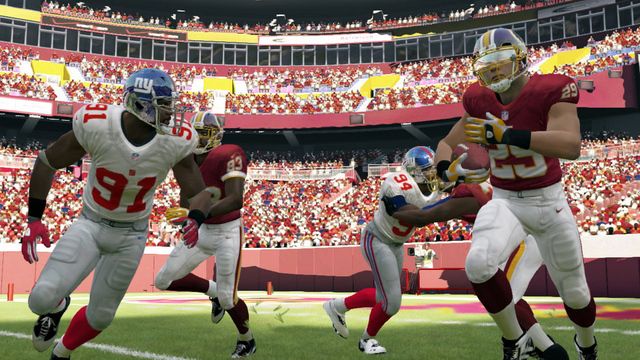Note: Portions of this review appeared in our PS3 review of Madden NFL 13.
Another year, another Madden. With literally no competition, it’s either Madden or gaining 200 lbs and putting on tights if you want to play NFL football. That being the case, Madden is not a hard sell. So long as EA refines the game graphically and updates the rosters, it’s a guaranteed purchase. What's more difficult, however, is selling a brand new Madden halfway through the season, which is what is effectively being done here. With most series diehards long underway in the 360/PS3 versions, the Wii U version will be a hard sell. Lucky for EA, the Wii U GamePad interactivity is impressive enough that even those who already own the game will be tempted to double-dip.
As expected, gameplay largely remains the same. Those who've played Madden the past five years can gloss over this section, but let’s recap for those living under a rock. After choosing one of 32 NFL teams, players control both the team’s offense and defense. As it’d be impossible to manage all eleven players at once, control shifts to whoever has the ball. Beginning as a quarterback, the ball can be handed off for a run or passed to a receiver. Receivers are marked with one of four face buttons. Simply hold down the corresponding button to throw the ball. If the pass is caught, control shifts to the receiver who must avoid defenders while running towards the goal line. There’s many variations at play such as pump fakes, audibles, spins and hurdles that also must be taken into account. It’s an easy to grasp, enjoyable formula that continues to serve the series well.
While the gameplay may be the same, the engine certainly isn’t. Making its debut is “The Infinity Engine”, accounting for player attributes such as mass, speed and body type in every play. Player interactions feel more realistic, such as a Quarterback throwing a wobbly ball after getting his arm grazed or receivers crashing harder to the ground. One of most impressive features of the Infinity Engine is its ability to run calculations during impacts to determine how the player will react. With this balance system, players can now regain their footing to continue plays. Body types even factor into the equation; a large player may have a better chance avoiding falling versus a smaller player in the same play.
Another cool feature is receiver awareness. In previous entries, receivers could unrealistically catch balls as they were looking forward. The new system actually ghosts player icons until the receiver is ready for the catch. While the ball can be thrown to ghosted players, the chance of completing a pass is highly unlikely. It’s a nice touch that adds a noticeable level of realism. One of the most impressive aspects of the engine is "Read and React Defensive AI”. In previous games, receivers who weren’t looking for the ball could blindly break up plays. Now, players can only respond to balls they can actively see. While this may not seem important, imagine the frustration that will be spared from seemingly impossible interceptions.
The Infinity Engine contributes to the game looking as realistic as it ever has, with many matches accurately mimicking gameday broadcasts. Players and coaches mirror their real life counterparts like never before, capturing obscure facial details of the players such as forehead wrinkles and hairlines. Lighting has been greatly improved, now tracking the position of the sun based on the time and lighting the field accordingly. EA has even gone so far as to correctly position the broadcast boost for commentators Jim Nantz and Phill Simms.
Besides looking the part, NFL on CBS’ Nantz and Simms also do a great job with their commentary, offering relevant observations throughout snaps. While the commentary can never perfectly reflect in-game action, the 9,000 unique lines certainly don’t hurt. Recorded with 24 tracks, the crowd sounds very immersive and fills surround speakers. The biggest downside audio-wise is the omission of EA Trax. For many years, Madden games offered a slew of tracks from licensed artists. Madden 13 nixes the feature in favor of an original score. Unfortunately, the score is boring and often times derivative, with one track sounding way too close to the Jurassic Park theme. Granted, Madden 12 didn’t have the best song selection, but losing EA Trax sees Madden 13 losing some of its immediacy. The game just doesn’t feel as current without them.
While Madden could have simply been thrown on the Wii U with rushed GamePad menus, EA has done a commendable job of taking advantage of all the features the tablet controller has to offer. The most notable addition is the ability to playcall from the GamePad screen itself. Instead of having to quickly browse through the circles and squiggles in tiny boxes on the TV screen, it's all right there on the controller, freeing up the TV from the usual clutter in between snaps. Not only does it benefit those who sit far back from their TV, but almost makes it feel as if you are controlling a live game on TV. What's more, the TV can be completely taken out of the equation by holding down the "minus" button three seconds in the main menu and switching to "Detached Mode", allowing diehards to play the game as their significant other watches TV (or views live football; imagine that).
Instead of simply selecting plays, however, EA has taken it a step further by adding custom hot routes. While pre-decided routes are still used, they can be changed at any time by selecting the receiver with a finger and dragging it in the desired direction. It may not seem all that notable, but it adds an important level of personalization to the proceedings that increases the player's impact on the game. For the defensive side of things, the same concept can be used to change the assignment of a player, making detecting audibles much easier and enjoyable. Perhaps the biggest impact seen on a regular basis is the ability to swap players by simply tapping their icon on the touchscreen instead of desperately cycling through them before the opposing team snaps the ball. This makes switching players considerably easier and relieves a substantial amount of confusion and frustration from the proceedings. Those who play local multiplayer will also be impressed to find that if both have Wii U Game Pads (or one is content using a Wii Remote or Pro Controller), the plays for at least one of them will show up on the Game Pad, preventing "accidental" screen peaking.
Closing Comments:
Madden NFL 13 is the first Wii U port we've played that uses the console to make a notable impact on gameplay. Instead of simply throwing in disposable features, time was taken to ensure the GamePad was utilized to its full potential. Diehard fans and casual players alike will relish in the ability of having a second screen to playcall, while the addition of custom hot routes and defensive changes add a whole new dimension to Madden. While it's hard to recommend buying the game to those who already have it (although tempting), anyone who has yet to experience the only pro football game in town shouldn't overlook this launch game -- even if the playoffs are already around the corner.
Version Reviewed: Wii U





